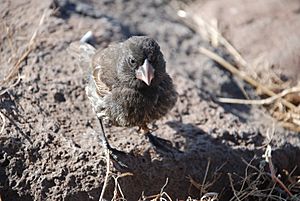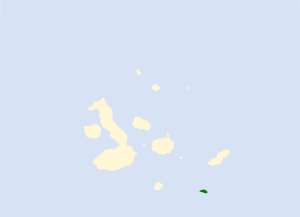Española cactus finch facts for kids
Quick facts for kids Española cactus finch |
|
|---|---|
 |
|
| On Española Island, the Galápagos Islands, Ecuador | |
| Conservation status | |
| Scientific classification | |
| Genus: |
Geospiza
|
| Species: |
conirostris
|
 |
|
The Española cactus finch (its scientific name is Geospiza conirostris) is a type of bird. It belongs to the tanager family. This bird is one of the famous Darwin's finches. It lives only on the Galápagos Islands. You can find it on Española, Genovesa, and the Darwin and Wolf Islands.
It's a dark-colored bird. It looks a bit like the common cactus finch, but it has a bigger beak. These two finches do not live on the same islands. The Española cactus finch likes to live in dry, bushy areas. You often see it walking on the ground. Its favorite food is the Opuntia cactus.
Contents
Where Does This Finch Come From?
The Española cactus finch is part of a group called Darwin's finches. These birds are closely related. They all evolved on the Galápagos Islands. This group is related to the Tiaris grassquits. Grassquits are small birds found in South America and the Caribbean.
About 2 to 3 million years ago, an ancestor of these grassquits arrived on the Galápagos Islands. The Española cactus finch is one of the many species that grew from that ancestor.
In 2015, a study showed something interesting. The Española cactus finch from Española Island is more closely related to the large ground finch. It is not as closely related to the Genovesa cactus finch. Because of this study, the International Ornithologists' Union changed how they group these birds. However, some other bird experts still group the large cactus finch and the Genovesa cactus finch together.
How New Species Are Made
Scientists got to see a new species form right before their eyes! The Española cactus finch (G. conirostris) first arrived on Daphne Major island in 1981. Scientists Peter and Rosemary Grant noticed it was a newcomer.
At first, these new finches bred with the local finches (G. fortis). But over time, their children stopped breeding with the local finches. These new descendants became a completely separate species. This was the first time scientists directly saw a new species being created in nature.
Later studies looked at the genes of these finches. They found that certain genes are very important. Genes for beak shape (called ALX1) and beak size (called HMGA2) help keep the new species separate. Genes related to the finches' song might also play a role.
What Does This Finch Look Like?
The Española cactus finch is one of the largest Darwin's finches. It grows to be about 15 cm (5.9 in) long.
Male finches are black. They have white tips on the feathers under their tail. Female and young finches are different colors. They can be dull gray or matte black. They often have white edges on the feathers of their undersides.
See also
 In Spanish: Pinzón de Darwin conirrostro para niños
In Spanish: Pinzón de Darwin conirrostro para niños




